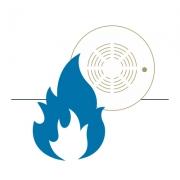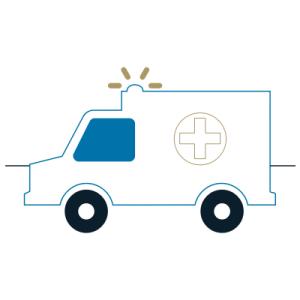Emergency Procedures
The GW Emergency Procedures provides action steps on what to do in a variety of situations.
- PROTECTIVE ACTIONS
In an emergency, campus safety officials will share the Protective Action messages through GW Alert, on-campus displays, and via other communications, such as social media. Click on the links to learn more!
Shelter Evacuate Secure Lockdown - FIRE
-
- If you sense smoke or fire, pull the fire alarm
- Leave the building immediately using the closest emergency exit
- Close doors behind you
- Call 911 when safe to do so
- Move away from the front of the building
- Re-enter the building only when instructed by officials
Do not assume an alarm is false
Use stairs, do not use elevators
If unable to exit the building, go to the nearest exit stairwell or safe area of refuge and call GW Emergency Services (202-994-6111) or 911 to report your location
If trained, use a fire extinguisher if the fire is small and contained, and room is not filled with smoke
- SEVERE WEATHER
Thunderstorms are the most common type of severe weather in the Washington, DC metropolitan area. However, winter storms, extreme hot/ cold temperatures, flooding, tornadoes, and hurricanes can occur. Check CampusAdvisories.gwu.edu for up-to-date weather advisories and information.
Shelter-in-place for severe thunderstorms and tornadoes:
- Seek shelter indoors in a low part of the building
- Move to a windowless interior room away from hazardous materials
- Take cover under a sturdy object or against an interior wall
- Monitor Campus Advisories and local media
- Wait for the all clear before leaving your safe place
- EARTHQUAKE
- Drop to the ground, take cover under a sturdy object and hold on until shaking stops
- If a sturdy object is not available, move to an inside corner of the room, crouch down and cover face and head with arms
- Stay away from glass, outside walls or anything that could fall
- Stay inside and wait for the all clear before leaving your safe space
- Do not use elevators
- Monitor Campus Advisories and local media
- MEDICAL EMERGENCY
- Call GW Emergency Services/EMeRG (202-994-6111) or 911 immediately
- Provide the location, nature of injury or illness, current condition of the victim and other requested information
- Remain on the phone until directed to hang up
- Stay with the victim
- Do not move the victim unless the individual is in immediate danger
- UTILITY FAILURE
Utility failures include power outages, gas leaks; unusual orders, flooding/plumbing problems, broken or malfunctioning life-safety equipment or elevator entrapment.
- Move to a safe area
- Call Emergency Maintenance (202-994-6706) to report issues
- Be prepared to provide failure type and location
- Building may be evacuated due to utility failures
- BIOLOGICAL RELEASE/ CHEMICAL SPILL
- Secure area and do not attempt to clean unless properly trained in managing biological releases or chemical spills
- Move to a safe area
- Call GW Emergency Services (202–994–6111) and provide information on location and type of release or spill
- If the release or spill has the potential to impact a larger area, notify GW Emergency Services (202-994-6111) of that potential release or spill and follow their directions
- SUSPICIOUS/ UNUSUAL PACKAGE OR MAIL
- Do not open the item(s)
- Leave the area and close doors behind you
- Call GW Emergency Services (202-994-6111) or 911 and provide a detailed description of the item(s), why it is suspicious and its location
- SUSPICIOUS PERSON
- Call GW Emergency Services/GWPD (202-994-6111)
- Do not confront the person or let the suspicious person into a locked building or office
- Do not block the person’s access to an exit
- If safe to do so, take a picture/photo of the person
- BOMB THREAT
Obtain as much information as possible from the caller and report the threat immediately to GW Emergency Services (202–994–6111).
Be sure to note:- Precise time of the call
- Caller’s exact words
- Noticeable characteristics of the caller (gender, age, calm/angry, excited/slow, accent, stutter, lisp, high/low pitched, etc.)
- Information regarding the device and possible location
- Background sounds (machine, voices, street noises, music, etc.)
- Threat language (well-spoken, taped, irrational, foul,
incoherent, etc.)
Ask the person questions, such as:
- Where is the bomb located?
- When will the bomb explode?
- What does the bomb look like?
- What kind of bomb is it?
- What will cause it to explode?
- Did you place the bomb?
- If so, why?
- If not, who did?
- What is your name?
- What is your address?
- VIOLENCE/ ACTIVE SHOOTER
If an active shooter is in your vicinity:
- Call 911 when it is safe to do so and provide information, including the location and number of shooters, description of the shooter(s), weapons used and number of potential victims
RUN
If there is an accessible escape path, attempt to evacuate the premises: Have an escape route and plan in mind
- Evacuate regardless if others agree to follow
- Leave your belongings behind
- Help others escape if possible
- Prevent others from entering an area where the active shooter may be
- Keep your hands visible
- Follow the instructions of any police officers
- Do not attempt to move wounded people
HIDE
If evacuation is not possible, find a place to hide where the active shooter is less likely to find you:
- Hide in an area out of the shooter's view
- Find protection if shots are fired in your direction
- Lock the doors
- Block entry to your hiding place with heavy objects or furniture pieces
- Silence your cell phone and stay quiet
- Spread out: Do not huddle together
- Wait for law enforcement
FIGHT
As a last resort and only when your life is in imminent danger, attempt to disrupt and/or incapacitate the shooter by:
- Devise a plan; Commit to your actions
- Throwing items and improvising weapons
- Acting as aggressively as possible against the individual
- Yelling
*Adapted from DHS Active Shooter Guidelines, DHS.gov
- CRIME
-
Criminal acts towards persons or property can occur on or office campus. Be sure to:
- Remain in or move to a safe area
- Report criminal or suspicious activity to GWPD (202-994-6111) or 911
- ASSISTING PEOPLE WITH ACCESS AND FUNCTIONAL NEEDS
Blind or Visually Impaired:
- Clearly, announce the emergency
- Offer your arm for guidance
- Lead the person and alert them of obstacles
Deaf or Hard of Hearing:
- Turn lights on and off to gain the person's attention
- Indicate directions with gestures or a written note
Mobility-Impaired:
- Guide the person to the nearest exit stairwell or safe area of refuge
- Do not use elevators
- Call GW Emergency Services (202-994-6111) or 911 to report your location
- Stay with the person if it can be done without unreasonable personal risk
- If in imminent danger and the person request assistance before emergency personnel can arrive, find volunteers to evacuate the person per their instructions
WEATHER TERMS:
- WATCH: Conditions are favorable or expected
- WARNING: Conditions are occurring or imminent
















